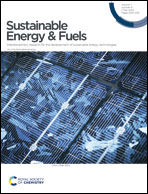Understanding green-hydrocarbon production through the strategy of biomass ketalization reaction†
Abstract
The use of oil refineries to convert second generation biomass (BM) into fuels is a powerful approach to reduce the carbon footprint. However, BM undergoes parallel reactions, yielding undesirable products during its transformation chain. We overcame this limitation by converting BM under mild conditions using acetone, obtaining a new bio-petroleum (BP) composed of sugar acetals, without carbon loss. We studied the conversion of DX, 1,2:3,5-di-O-isopropylidene-α-D-xylofuranose, a major component in BP, into hydrocarbons to obtain insights into the DX transformation pathway and how DX and its derivatives interact with hydrocarbons present in the reaction medium. DX mixed with hydrocarbons (10 to 20 wt%) was cracked by beta zeolite at 500 °C in a fixed bed reactor. The hydrocarbons competed with DX for the active sites of the zeolite, slightly decreasing the transformation of DX and its intermediates in increasing order: n-hexane < cyclohexane < methylcyclohexane < toluene (pattern further supported by DFT calculations). The hydrocarbons with increasing hydrogen transfer capacity increased the yields of aromatics and naphthenics and the level of green carbon incorporated as useful products (85–90%). We observed that water was the first product of deoxygenation. Then acetone and furans were important intermediates for subsequent decarbonylation and decarboxylation, yielding hydrocarbons. DX reduced the hydrocarbon protolysis of both σC–C and σC–H bonds, decreasing the formation of H2 and light hydrocarbons while the co-feed (intermediates) contributed to the formation of aromatics (enabling a bimolecular reaction with oxygenates). These insights may be used to improve the catalysts and the process of BP conversion into target products.



 Please wait while we load your content...
Please wait while we load your content...